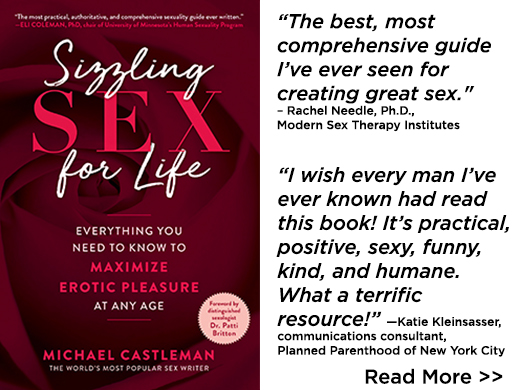
Sustained eye-gazing increases trust, intimacy, and sexual pleasure. Sexologists almost universally recommend extended, gentle, playful, mutual whole-body caressing as a key ingredient of satisfying lovemaking. But people can also caress each other without actually touching—by gazing into one another’s eyes.
A 16th-century French poet was the first to observe, “The eyes are the windows of the soul.” Two hundred years later, in 1967, the English singer Dusty Springfield had a hit with “The Look of Love:”
The look of love
Is in your eyes,
The look your smile can’t disguise
The look of love
Is saying so much more
Than just words could ever say.
And what my heart has heard,
It takes my breath away.
Modern science has proven both correct. When two people gaze into each other’s eyes for more than two minutes or so, they develop deeper trust, greater intimacy, more passionate mutual attraction—and as a result, better sex.
The Classic Studies
In 1989, researchers at Clark University in Worcester, Massachusetts, were the first to explore the power of mutual eye-gazing in two studies that have become classics. First, they divided 96 strangers into pairs and asked them to do one of three things: stare at each other’s hands, count each other’s eye blinks (superficial eye contact), or gaze intently into each other’s eyes (deep eye contact). Subjects who gazed into each other’s eyes reported the greatest feelings of attraction and affection.
Next, the researchers asked 144 coupled individuals how much they liked their partners and how passionately they loved them. The 72 couples then gazed into each other’s eyes for two minutes—no talking, just looking deeply into each other’s eyes. The result: Mutual attraction and passion increased significantly.
The Look of Love
Some evidence suggests that prolonged eye contact spurs the nervous system to release two compounds, oxytocin and phenylethylamine. The former is a hormone, sometimes called the “cuddle hormone,” associated with long-term bonding and attachment. The latter, sometimes called the “love chemical,” is a neurotransmitter involved in feelings of interpersonal attraction.
These compounds affect us almost from birth. Five-day-old babies prefer looking at faces that make direct eye contact compared with faces that have an averted gaze. And in infants and toddlers, the inability to maintain eye contact is one of the early signs of autism.
Many studies have documented the surprising emotional power of mutual eye gazing:
- French researchers used functional magnetic resonance imagery (fMRI) to measure changes in blood flow through the amygdala, the area of the brain that processes emotions. Averted gazes had no impact on blood flow into the amygdala, but during eye gazing, it increased significantly.
- Cal Tech investigators found that as time spent in mutual eye gazing increased, the two people usually found each other’s faces more attractive.
- Scientists at the University of Western Austraila asked 32 men to look at two photographs of women whose faces displayed neutral expressions. In one, the women’s gazes were averted. In the other, they looked directly into the camera, which allowed the men to look into their eyes. The men considered the latter group more attractive.
- German researchers showed volunteers videos of people making statements that were either true or not. In some, the speakers looked off into the distance. In others, they looked directly into the camera. Study participants were more likely to believe the statements spoken by speakers looking directly at them. In addition, when subjects disagreed with statements, they were slower to voice their opposition when the speaker looked directly at them.
- When strangers interact for the first time, they may or may not bond emotionally. Chinese investigators asked volunteers to view faces of strangers’ whose gazes were either averted or directed toward them. Participants agreed that the strangers who looked directly at them were more similar to them and more likely to become their friends.
Finally, mutual eye gazing also involves sharing undivided attention. In a world dominated by phones ringing, texts beeping, emails calling, and social media always beckoning, undivided attention is a special gift, one that many people find compelling.
While eye gazing usually boosts feelings of attraction, closeness, and even love, it may also trigger fear and anxiety. Repeated eye gazing might turn things in a more positive direction, or you might diminish the amount of eye gazing you do.
Eye Gazing for Deeper Intimacy and Hotter Sex
Many therapists recommend extended eye gazing to couples who feel alienated, or to couples who get along fine but hope to feel closer:
- Arrange two chairs so you sit comfortably facing each other with your knees touching. That puts you close enough to look deeply into each other’s eyes.
- Close your eyes,. Empty your mind as best you can. And take 10 slow, deep breaths. This meditative breathing calms the nervous system and primes you for greater intimacy.
- Then open your eyes and look directly into your partner’s. No talking, just eye-gazing. Breathe slowly and deeply. Feel free to blink. Smile.
- Continue eye-gazing for five minutes. If you like, set a timer. If your attention wanders, no problem. Simply return to looking into your partner’s eyes.
- After five minutes, close your eyes again and together take another 10 deep breaths.
- Open your eyes. Stand. Hug your partner.
There’s no guarantee that this little exercise will bring you closer or prime you for sizzling sex. For some people, it doesn’t. But most couples find that eye gazing reduces interpersonal tensions, and makes partners more attractive, and more erotically alluring.





